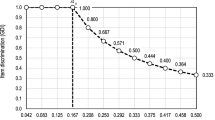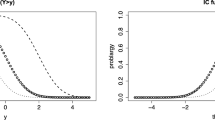Abstract
The item response function (IRF) for a polytomously scored item is defined as a weighted sum of the item category response functions (ICRF, the probability of getting a particular score for a randomly sampled examinee of ability θ). This paper establishes the correspondence between an IRF and a unique set of ICRFs for two of the most commonly used polytomous IRT models (the partial credit models and the graded response model). Specifically, a proof of the following assertion is provided for these models: If two items have the same IRF, then they must have the same number of categories; moreover, they must consist of the same ICRFs. As a corollary, for the Rasch dichotomous model, if two tests have the same test characteristic function (TCF), then they must have the same number of items. Moreover, for each item in one of the tests, an item in the other test with an identical IRF must exist. Theoretical as well as practical implications of these results are discussed.
Similar content being viewed by others
References
Andrich, D. (1978). A rating formulation for ordered response categories.Psychometrika, 43, 516–573.
Bock, R. D. (1972). Estimating item parameters and latent ability when the responses are scored in two or more nominal categories.Psychometrika, 37, 29–51.
Chang, H., Mazzeo, J., & Roussos, L. (1993, April).Extension of Shealy-Stout's DIF procedures to polytomously scored items. Paper presented at the 1993 NCME meeting, Atlanta, GA.
Masters, G. N. (1982). A Rasch model for partial credit scoring.Psychometrika, 47, 149–174.
Muraki, E. (1992). A generalized partial credit model: application of an EM algorithm.Applied Psychological Measurement, 16, 159–176.
Samejima, F. (1969). Estimation of latent ability using a response pattern of graded scores.Psychometrika Monograph No. 17, 34 (4, Pt. 2).
Samejima, F. (1972). A general model for free-response data.Psychometrika Monograph No. 18, 37 (1, Pt. 2).
Shealy, R., & Stout, W. (1993). A model-based standardization approach that separates true bias/DIF from group ability differences and detects test bias/DTF as well as item bias/DIF.Psychometrika, 58, 159–194.
Thissen, D., & Steinberg, L. (1986). A taxonomy of item response models.Psychometrika, 51, 567–577.
Wilson, M., & Masters, G. N. (1993). The partial credit model and null categories.Psychometrika, 58, 87–99.
Wright, B., & Masters, G. N. (1982).Rating scale analysis. Chicago: MESA Press.
Author information
Authors and Affiliations
Additional information
This research was supported by Educational Testing Service Allocation Projects No. 79409 and No. 79413. The authors wish to thank John Donoghue, Ming-Mei Wang, Rebecca Zwick, and Zhiliang Ying for their useful comments and discussions. The authors also wish to thank three anonymous reviewers for their comments.
Rights and permissions
About this article
Cite this article
Chang, HH., Mazzeo, J. The unique correspondence of the item response function and item category response functions in polytomously scored item response models. Psychometrika 59, 391–404 (1994). https://doi.org/10.1007/BF02296132
Received:
Revised:
Issue Date:
DOI: https://doi.org/10.1007/BF02296132




